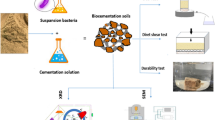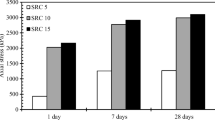Abstract
The SG compound admixture comprising sodium silicate and gypsum was introduced into cement-solidified mucky soil and investigated using orthogonal testing. Unconfined compressive strength, three durability tests (i.e., water immersion, cyclic dry–wet, and cyclic freeze–thaw tests), scanning electron microscopy (SEM), and X-ray diffraction (XRD) analysis were conducted to optimize the composition of the additive agent and its content required to stabilize most effectively mucky soil. To study the different age and cement-SG mud quality and effectiveness of stabilized soil and its driving mechanism. The results show that there was an optimal content of cement-SG curing agent achieved with 18% of cement and 12.64% of SG additive of the mass of mucky soil. The curing strength reached the maximum values of 1160 kPa and 2617 kPa after 7 and 90 days. The strengthening effect of cement-SG composite-solidifying agent with the same mass content was markedly better than that of pure cement at different ages. Using SEM and XRD analysis of cement-SG solidified soil at the age of 28 days, it was found that the contents of calcium hydroxide crystals, calcium silicate hydrate, and ettringite in cement-SG-solidified soil are higher than those in cement-solidified soil, which significantly enhances the compactness of cement-SG-solidified soil compared to that of cement-solidified soil. Cement-SG-solidified soil was also superior to cement-solidified soil in impermeability, freeze–thaw resistance, and dry–wet resistance.





















Similar content being viewed by others
Data Availability
The open project of Guangxi Key Laboratory for Disaster Prevention, Reduction and Structural Safety, project approval No. 2019ZDK051, 2019.10.30-2021.9.30.
References
Abbey SJ, Eyo EU, Ng’ambi S (2020) Swell and microstructural characteristics of high-plasticity clay blended with cement. Bull Eng Geol Environ 79(4):2119–2130
Barcelo L, Kline J, Walenta G, Gartner E (2013) Cement and carbon emissions. Mater Struct 47:1055–1065
Cao ML, Ming X, He KY, Li L, Shen S (2019) Effect of macro-, micro- and nano-calcium carbonate on properties of cementitious composites-a review. Materials 12(5):781
Chai J, Shrestha S, Hino T (2019) Failure of an embankment on soil-cement column-improved clay deposit: investigation and Analysis. J Geotech Geoenviron 145(9):05019006-05011–10
Chen HE, Wang Q (2005) Influences of organic matter on the effect of consolidating soft soil with cement. Chin J Rock Mech Eng 24(S2):5816–5821
Chen H, Wang Q (2006) The behaviour of organic matter in the process of soft soil stabilization using cement. Bull Eng Geol Environ 65(4):445–448
Güllü H (2015) Unconfined compressive strength and freeze-thaw resistance of fine-grained soil stabilised with bottom ash, lime and superplasticiser. Road Mater Pavement 16(3):608–634
Jian WB, Zhang D, Huang CX (2013) Micromechanism of cement-sodium silicate-stabilized soft soils. Geotech Eng 35(Supp. 2):632–637
Kazemian S, Prasad A, Huat BBK, Bazaz JB, Mohammed TA, Aziz FNA (2011) Effect of aggressive pH media on peat treated by cement and sodium silicate grout. J Cen South Univ Technol 18(3):840–847
Latifi N, Vahedifard F, Siddiqua S, Horpibulsuk S (2018) Solidification-stabilization of heavy metal-contaminated clays using gypsum: multiscale assessment. Int J Geomech 11:1532–3641
Liu JM, Ou ZW, Xiao HB, Mo JC, Yang KH (2017) Effect of functional components on early strength of solidified soil. Geotech Mech 38(3):755–761 (In Chinese)
Ma C, Chen LZ, Chen B (2014) Analysis of strength development in soft clay stabilized with cement-based stabilizer. Constr Build Mater 71:354–362
Petry TM, Little DN (2002) Review of stabilization of clays and expansive soils in pavements and lightly loaded structures - history practice, and future. J Mater Civil Eng 14(6):447–460
Prusinski JR, Bhattacharja S (1999) Effectiveness of Portland cement and lime in stabilizing clay soils. Transp Res Rec 1652(1):215–227
Raoul J, Franck R, Damien R, Laurent M (2011) Stabilisation of estuarine silt with lime and/or cement. Appl Clay Sci 50(3):395–400
Shi C, Zhang G, He TS, Li YM (2016) Effects of superplasticizers on the stability and morphology of ettringite. Constr Build Mater 112:261–266
Shirazi H (1999) Field and laboratory evaluation of the use of lime fly ash to replace soil cement as a base course. Transp Res Rec 1652:270–275
Valls S, Vazquez E (2000) Stabilisation and solidification of sewage sludges with Portland cement. Cem Concr Res 30(10):1671–1678
Yang L, Yilmaz E, Li JW, Liu H, Jiang HQ (2018) Effect of superplasticizer type and dosage on fluidity and strength behavior of cemented tailings backfill with different solid contents. Constr Build Mater 187:290–298
Yao K, Pan YT, Jia L, Yi JT, Hu J, Wu CZ (2020) Strength evaluation of marine clay stabilized by cementitious binder. Mar Georesour Geotec 38(6):730–743
Zhou H (2013) Study on soft soil microstructure and mechanism of seepage and consolidation in pearl river delta (PRD). South China University of Technology, Guangzhou
Zou WL, He Y, Zhang FD, Wang DX, Wang S, Wang YM (2017) Experimental study on unsaturated permeability characteristics of solidified sediment stabilized with cement. J Zhejiang Univ Nat Sci Ed 51(11):2182–2188
Funding
This work was supported by the Systematic Project of Guangxi Key Laboratory of Disaster Prevention and Engineering Safety (Grant No. 2019ZDK051).
Author information
Authors and Affiliations
Corresponding author
Rights and permissions
Springer Nature or its licensor (e.g. a society or other partner) holds exclusive rights to this article under a publishing agreement with the author(s) or other rightsholder(s); author self-archiving of the accepted manuscript version of this article is solely governed by the terms of such publishing agreement and applicable law.
About this article
Cite this article
Wei, M., Yang, Y., Xiong, L. et al. Cement-SG curing agent for solidification of mucky soils. Bull Eng Geol Environ 82, 236 (2023). https://doi.org/10.1007/s10064-023-03241-0
Received:
Accepted:
Published:
DOI: https://doi.org/10.1007/s10064-023-03241-0




